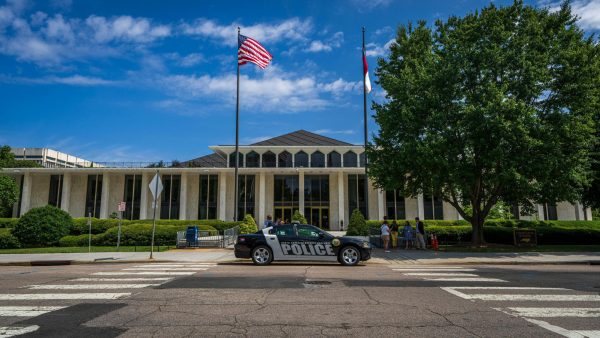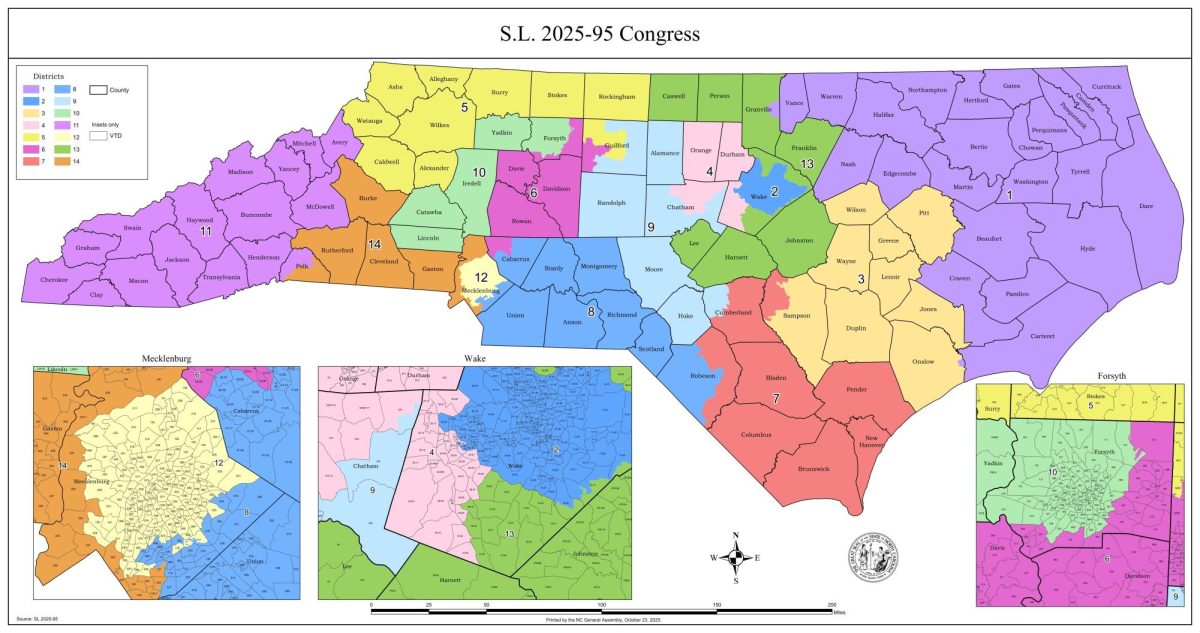For the fifth year in a row, North Carolina is starting over with its congressional map. The latest map, approved last Tuesday, Oct. 21, marks the state’s fifth redraw in just five years. Leading up to the 2026 midterm elections, Republicans are expected to gain one extra seat from the new map. Though Southeastern N.C. counties, including New Hanover, will remain in district, seven, — 500,000 people in Eastern N.C. will shift between the first and the third.
Sen. Brent Jackson of Pender County was the only Southeastern tri-county representative present to approve the new map. Sen. Bill Raben of Brunswick County as well as Sen. Michael Lee of New Hanover County were given excused absences, forfeiting their votes. New Hanover County Rep. Deb Butler came out in clear opposition to the new map, calling it “an attempt to elicit an endorsement from the president because [Sen. Phil Berger] knows he’s floundering in his primary.” knows he’s floundering in his primary.”
State Senate leaders claim that this year’s redraw is an attempt to protect the Trump administration’s agenda, along with Republican control of Congress. State Senate leader, Phil Berger, and State House Speaker, Destin Hall, released a joint statement in defense of the new map on Tuesday afternoon.
“Our state won’t stand by while Democrats like Gavin Newsom redraw districts to aid in their effort to obtain a majority in the U.S. House,” stated Hall. “We will not allow them to undermine the will of the voters and President Trump’s agenda.”
“President Trump delivered countless victories during his first term in office, and nine months into his second term, he continues to achieve unprecedented wins,” Berger added. “We are doing everything we can to protect President Trump’s agenda, which means safeguarding Republican control of Congress.”
Berger followed this with a post on the X platform shortly after the map’s approval, sharing a photo of Trump and himself alongside it.
Mere days after its approval, the new congressional map has been faced with an abundance of criticism in North Carolina, as well as across the country. Republicans already control 10 out of 14 congressional districts in the state following a heavily gerrymandered map in 2023. The new map is likely to give them another extra seat in the First Congressional District.
The First Congressional District previously included all eight of North Carolina’s majority Black and ethnic minority counties. Now, the map includes more conservative-leaning counties in that district. The previous First District’s proportion of Black voters was approximately 40% higher than any other in the state. Under the new map, that proportion drops to 32%. Alongside it, the proportion of black voters in the Third District rises only slightly to 29%.
In the 2024 election, Trump received 51% of the popular vote in North Carolina, and Democratic governor Josh Stein was also elected the same year, establishing its presence as a swing state once again. Critics now claim that Democratic Rep. Don Davis represents the only true swing district in the state. Berger stands by the decision to redraw the map despite accusations of an “illegal racial gerrymander,” stating that “this new map respects the will of the North Carolina voters who sent President Trump to the White House three times.”

Though the N.C. Constitution does not allow Stein to veto the new congressional map, it is likely to receive legal challenge falling back on the Voting Rights Act of 1965. However, the U.S. Supreme Court recently voiced their criticism of one of the act’s key provisions: the ability to use race as a factor in a district redraw. They appear likely to weaken this aspect of it, possibly leading to widespread redistricting efforts across the nation that many believe will no longer support minority voters.
Bishop William Barber II, president of the national moral and social justice organization Repairers of the Breach, spoke out about his criticism of the new map outside of the N.C. Legislative Building on Thursday alongside fellow protestors. “The effort is racist,” Barber said. “It’s an attack on Black Belt counties.” He also confirmed his involvement in legal action that is expected to take place against the state’s new map. A previous lawsuit from the N.C. NAACP against Berger, over alleged violation of this act, went to trial the summer after the 2024 election, but a court decision has not been made yet.
Republican State Senators continue to defend the new map despite facing criticism, claiming to stand by President Trump and his administration’s plans for the country.
“We’re stepping into this redistricting battle because California and the radical left are attempting to rig the system to handpick who runs Congress,” said House Redistricting Chairmen Brenden Jones and Hugh Blackwell. “President Trump has called on us to fight back, and North Carolina stands ready to level the playing field.”
“North Carolina was the target of the Democrats’ sue-until-blue scheme, and we’re prepared to bring forward a new congressional map to defeat this new scheme,” added Senate Redistricting Chairman Ralph Hise.
As national scrutiny intensifies, North Carolina’s new congressional map is set to shape the state’s political landscape for the near future. Though New Hanover County’s lines may not have shifted, many believe the stakes for political tensions could. Wilmington voters alongside others across North Carolina will be casting ballots for the first time in the newly drawn districts on Nov. 3 in the 2026 midterm election. The results will not only shape North Carolina’s representation in Washington, but also determine the current political balance of the state. With just over a week to go until the elections take place, North Carolina Republicans and Democrats alike will be watching closely to gauge the state’s role on a national level.
For more information on midterm elections, registering to vote and New Hanover County’s voting policies, see “Brush up on your voting knowledge.”









